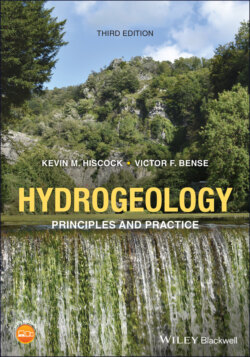Читать книгу Hydrogeology - Kevin M. Hiscock - Страница 12
Preface to the third edition
ОглавлениеThe scope of this book remains the same in presenting the study of hydrogeology and the significance of groundwater in the terrestrial aquatic environment. This new edition reflects developments in hydrogeology since publication of the second edition in 2014 and aims to capture contemporary topics linking groundwater resources to global challenges such as climate change, energy resources and groundwater depletion embedded in global crop production and trade. Advances in the availability of digital data and techniques for modelling global‐scale datasets have revealed the current state of groundwater resources worldwide, only further emphasizing the societal importance of groundwater as a natural resource. This third edition continues to be aimed at both students and practitioners in hydrogeology and related subjects. As in the previous two editions, this edition includes a set of exercises in Appendix 10, together with some new numerical problems, to assist students in gaining practice in problem solving in hydrogeology.
The overall structure and order of the book chapters remain largely the same, with Chapter 1 having undergone revision to present new insights into the distribution of groundwater in the Earth’s upper continental crust, groundwater‐related tipping points, the role of groundwater as an agent of global material and elemental fluxes, and the influence of humans on the water cycle. As an illustration of global groundwater challenges, a new box is included on groundwater quality and depletion in the Indo‐Gangetic Basin.
Chapters 2 and 3 cover basic principles of physical hydrogeology and the response of groundwater systems to geological processes. There is further presentation of the problems of land subsidence from groundwater over‐abstraction as observed using remote sensing methods in the Tehran Plain, Iran, and a new section on the types of sinkholes and triggers for their collapse.
Chapters 4 and 5 have been extended with new material on the relationships between geology, hydrogeological environment and groundwater chemistry and how these factors have influenced the location of British spa towns and the history of malting and brewing in Europe. The application of the stable isotopes of nitrogen and sulphur in groundwater investigations is presented in the context of regional hydrochemical processes. A new box illustrates the application of multiple environmental tracers in revealing groundwater processes with the example of fluid flow along faults in the Lower Rhine Embayment, Germany.
Chapter 6 has a new section on global‐scale surface water‐groundwater modelling and Chapter 7 includes new material on the phenomenon of terrestrial water loading by monsoon rains on groundwater level fluctuation in the Bengal Basin. Chapter 7 also extends the section on downhole and surface geophysical techniques as applied in hydrogeology.
Chapter 8 on contaminant hydrogeology has a new section on emerging contamination from microplastic pollution and the section on agricultural contaminants is extended to include a global assessment of nitrate stored in the vadose zone. A section on the problem of saline water intrusion on small oceanic islands is included, illustrated with the example of groundwater supply on the island of Malta in the Mediterranean Sea. Given the importance of karst groundwater resources in many areas of the world, Chapter 9 now considers methods for groundwater vulnerability assessment and mapping of carbonate aquifers with an example from the Grand Canyon, Arizona.
Chapter 10 has been expanded with new sections on the role of managed aquifer recharge in sustainable water management and on the linkages between groundwater and climate change. The response time of groundwater to climate change, the connection between groundwater pumping and global greenhouse gas emissions and the influence of global warming on cold‐region hydrogeology are all explored. The challenge of achieving net‐zero carbon emissions by 2050 is introduced with new material discussing the link between groundwater and energy resources with an introduction to geothermal energy resources, ground source heat pumps and shale gas exploration. Finally, and with a view to looking forward, this third edition concludes with an updated discussion of future challenges for groundwater governance and management.
Kevin Hiscock, Norwichand
Victor Bense, Wageningen
July 2021
